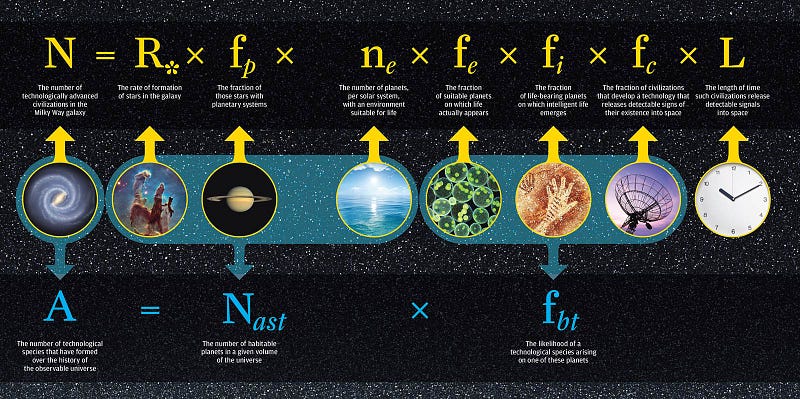The Drake Equation: A Catalyst for Cosmic Conversation
Written on
Chapter 1: Understanding the Drake Equation
The Drake Equation holds a prominent place in the field of astronomy, having sparked extensive debate and analysis over the years. Despite numerous attempts to 'solve' it, the equation itself remains unsolvable. So, what drives our interest in it?
The Drake Equation aims to estimate the number of intelligent extraterrestrial civilizations present in the Milky Way galaxy—or, by extension, the universe at large. Essentially, it poses the question: Are we the only ones traversing this vast cosmos? The equation is represented as follows:
N = R*fp*ne*fl*fi*fc*L
At first glance, this may seem complex, but it becomes clearer when we break it down into its components. Importantly, we won't be delving into actual calculations, but rather examining the conceptual framework behind the equation.
- N = the number of communicable intelligent civilizations in our galaxy.
- R* = the average rate of star formation in our galaxy.
- fp = the fraction of those stars that possess planets.
- ne = the average number of planets that could potentially support life around each star that has planets.
- fl = the fraction of planets that can support life and actually develop it.
- fi = the fraction of those planets with life that eventually evolve intelligent civilizations.
- fc = the fraction of civilizations that create technology capable of emitting detectable signals into space.
- L = the duration for which such civilizations produce detectable signals.
While the initial parameters can be estimated to some extent, the last four variables remain elusive. For instance, how can we estimate the fraction of planets that foster life without discovering life first? Our current sample size stands at one: Earth. Even within our solar system, discussions about the existence of life on Mars or Europa are ongoing and contentious. Until we find more evidence, estimating these variables will remain a challenge, particularly when considering life forms that may exist outside our own understanding.
But that’s not all! The other variables pose even greater complications for similar reasons. To determine how long civilizations emit these signals, we first need at least one measurement, which we don’t currently possess. Our civilization could be broadcasting radio waves for millions of years or could cease operations in mere decades. Gathering any meaningful statistics on these variables is virtually impossible unless we encounter multiple civilizations over an extended period—at which point, the necessity for the equation would likely diminish.

Chapter 2: The Purpose of the Drake Equation
So, what is the true purpose behind this equation? Surely Frank Drake, a PhD holder in astronomy, recognized its limitations. Indeed, he did. The equation is not intended to be definitively solved; rather, it serves as a stimulus for dialogue. Clearly, it has achieved this aim, as we find ourselves discussing it now.
I recall my first exposure to the equation in science class. The mere thought that we might describe such phenomena captivated me. It was far more engaging than mundane probability exercises like drawing marbles from a jar. The possibilities it presented occupied my thoughts for hours. This equation encouraged me to ponder our existence within the universe.
In essence, the spirit of the Drake Equation lies not in quantification but in understanding the multitude of factors that must align for a species to become a spacefaring civilization. It emphasizes the immense scale of the galaxy and the myriad possibilities it harbors. This is precisely why discussions around it persist—it serves as a foundation for exploring potentialities rather than probabilities.
Consider this: If we could somehow arrive at a reasonably accurate resolution for the equation, would it shift your perspective? If it indicated that we are likely alone in the galaxy, would we cease our search? Personally, I wouldn’t. If there exists even a slim chance that others inhabit this vast expanse, isn't it worth the endeavor to find them?
The Drake Equation doesn't necessitate a definitive solution. What we truly need is to continue our search. Who knows what discoveries await us? This quest is part of the grand adventure.
This video delves into why any potential solution to the Drake Equation could be unsettling, regardless of the outcome.
In this video, the host argues that the Drake Equation may be fundamentally flawed, offering insights into its limitations and implications.